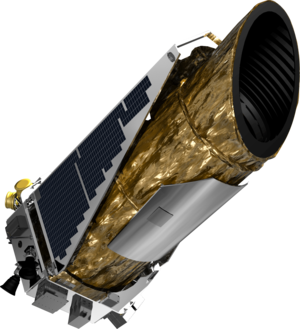The Kepler space telescope is a disused space telescope launched by NASA in 2009[5] to discover Earth-sized
planets orbiting other stars.[6][7] Named after astronomer Johannes Kepler,[8] the spacecraft was launched
into an Earth-trailing heliocentric orbit. The principal investigator was William J. Borucki. After nine
and a half years of operation, the telescope's reaction control system fuel was depleted, and NASA
announced its retirement on October 30, 2018.
Designed to survey a portion of Earth's region of the Milky Way to discover Earth-size exoplanets in or near
habitable zones and estimate how many of the billions of stars in the Milky Way have such planets,[6][11]
[12] Kepler's sole scientific instrument is a photometer that continually monitored the brightness of
approximately 150,000 main sequence stars in a fixed field of view.[13] These data were transmitted to
Earth, then analyzed to detect periodic dimming caused by exoplanets that cross in front of their host star.
kepler space telescope

Pre-launch development
The Kepler space telescope was part of NASA's Discovery Program of relatively low-cost science missions. The
telescope's construction and initial operation were managed by NASA's Jet Propulsion Laboratory, with Ball
Aerospace responsible for developing the Kepler flight system.
In January 2006, the project's launch was delayed eight months because of budget cuts and consolidation at NASA.
[16] It was delayed again by four months in March 2006 due to fiscal problems.[16] At this time, the
high-gain antenna was changed from a gimbal-led design to one fixed to the frame of the spacecraft to
reduce cost and complexity, at the cost of one observation day per month.
Spacecraft design
The telescope has a mass of 1,039 kilograms (2,291 lb) and contains a Schmidt camera with a 0.95-meter (37.4
in) front corrector plate (lens) feeding a 1.4-meter (55 in) primary mirror—at the time of its launch this
was the largest mirror on any telescope outside Earth orbit,[45] though the Herschel Space Observatory took
this title a few months later. Its telescope has a 115 deg2 (about 12-degree diameter) field of view (FoV),
roughly equivalent to the size of one's fist held at arm's length. Of this, 105 deg2 is of science
quality, with less than 11% vignetting. The photometer has a soft focus to provide excellent photometry,
rather than sharp images. The mission goal was a combined differential photometric precision (CDPP) of 20
ppm for a m(V)=12 Sun-like star for a 6.5-hour integration, though the observations fell short of this
objective (see mission status).
Field of view
Kepler has a fixed field of view (FOV) against the sky. The diagram to the right shows the celestial
coordinates and where the detector fields are located, along with the locations of a few bright stars with
celestial north at the top left corner. The mission website has a calculator[79] that will determine if a
given object falls in the FOV, and if so, where it will appear in the photo detector output data stream.
Data on exoplanet candidates is submitted to the Kepler Follow-up Program, or KFOP, to conduct follow-up
observations


